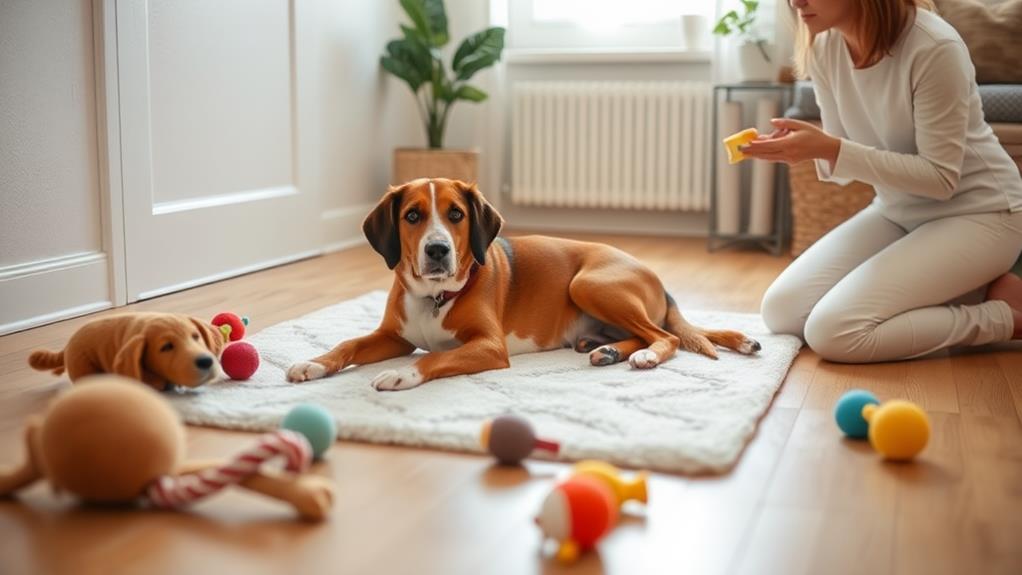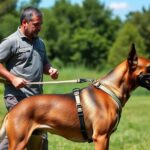To alleviate anxiety in your dog, start with positive reinforcement techniques. Reward desired behaviors with treats or praise to create a trusting bond. Consistency in your training routines also helps your dog feel secure; use the same cues across all family members. Establish a safe space where your dog can retreat during stressful times. Additionally, desensitize them to triggers gradually, pairing exposure with positive experiences. Regular exercise breaks pent-up energy, promoting relaxation, while socialization teaches essential cues. Incorporating these techniques will enhance your dog's confidence and calmness, and there's plenty more to explore to support your furry friend.
Understanding Dog Anxiety
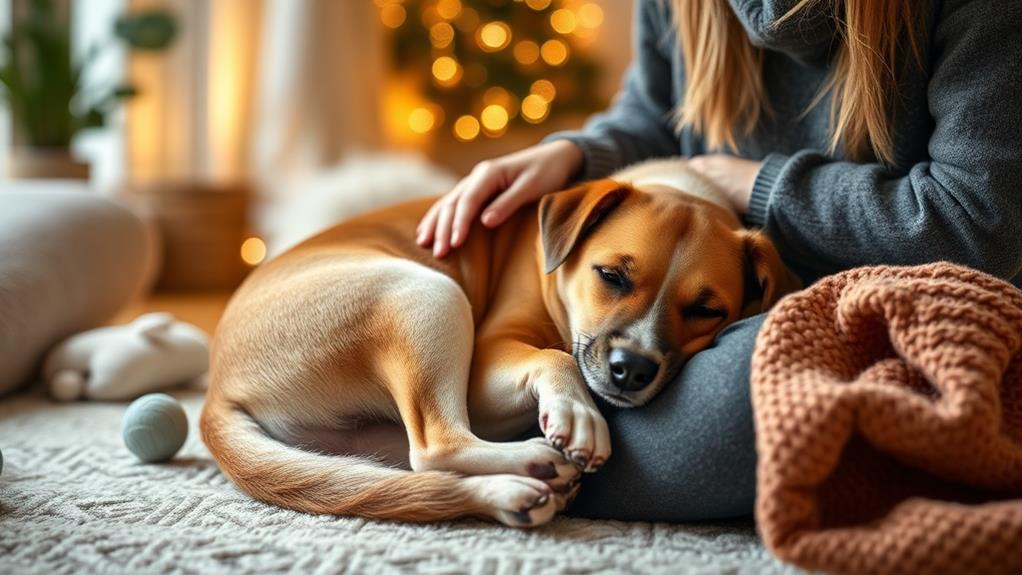
Dog anxiety can manifest in various forms, affecting your furry friend's behavior and overall well-being. You might notice signs of anxiety such as excessive barking, destructive chewing, or hiding when loud noises occur. These behaviors often indicate that your dog feels overwhelmed or scared. It's highly important to recognize that anxiety can stem from different sources, including separation, changes in routine, or unfamiliar environments.
When you understand the root causes of your dog's anxiety, you can begin to address it effectively. Your dog may experience anxiety during thunderstorms, fireworks, or even during your departure from home. Pay attention to their body language—ears back, tail tucked, and pacing can signal discomfort.
Recognizing these signs is the first step toward helping your dog feel more secure. It's absolutely essential to assess their environment and daily routine, as these factors can drastically impact their emotional state. By being observant and proactive, you can create a supportive atmosphere that fosters comfort and confidence. With patience and the right techniques, you can help your dog navigate their anxiety, improving their quality of life and strengthening your bond.
Importance of Consistency
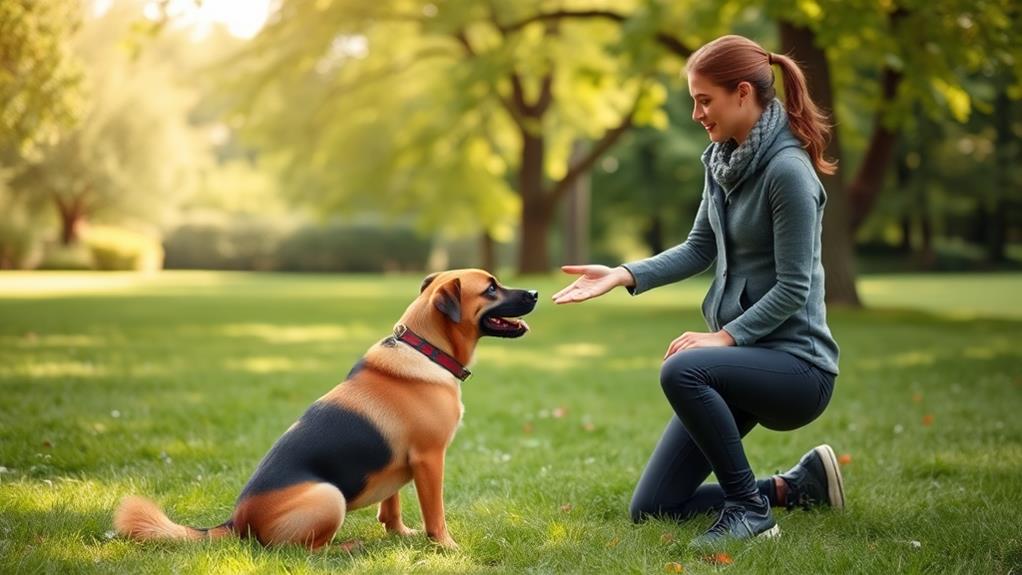
When training your dog to manage anxiety, consistency is key. Dogs thrive on routine and structure, so establishing consistent training schedules helps them feel secure. When you repeat commands and behaviors, your dog learns what to expect, making them more comfortable in potentially stressful situations.
It's essential to use the same cues and signals every time. If you're inconsistent with commands or responses, your dog can become confused, which might exacerbate their anxiety. For instance, if you use "sit" one day and "down" the next for the same action, your dog won't grasp what you want. Stick to one approach, and your dog will catch on faster.
Incorporating consistency into your training also means maintaining the same rules across different family members. If one person allows your dog on the couch while another doesn't, it creates mixed messages. Everyone involved in your dog's training should be on the same page to reinforce the same behaviors and rules. This unity helps your dog feel more secure and reduces anxiety triggers. By being consistent, you're not just training your dog; you're building a stronger bond based on trust and understanding.
Positive Reinforcement Techniques
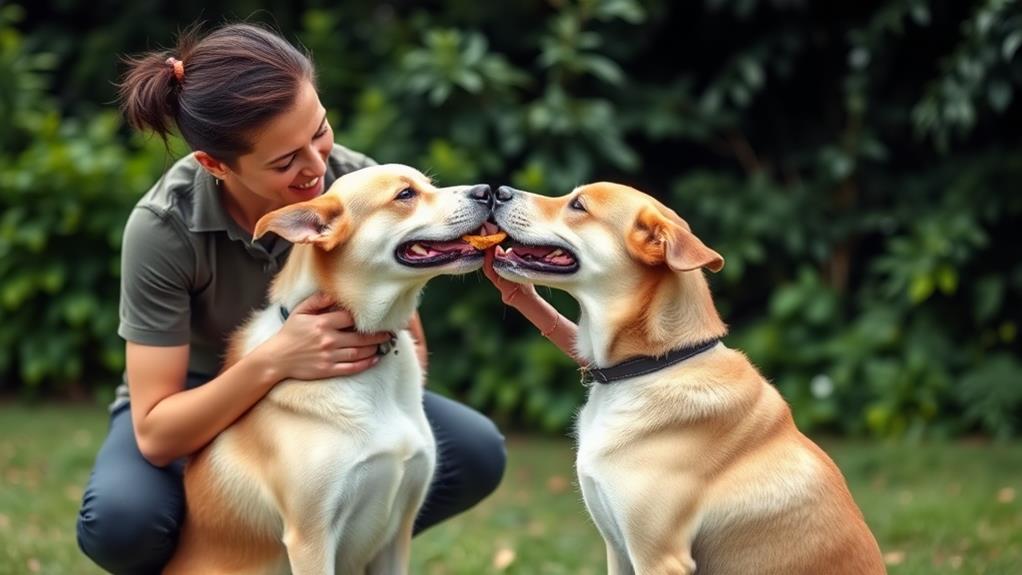
Building on the importance of consistency, positive reinforcement techniques can greatly enhance your dog's training experience and help reduce anxiety. By rewarding your dog for desired behaviors, you create a positive association that encourages them to repeat those actions. This method not only builds your dog's confidence but also fosters a trusting relationship between you both.
To effectively implement positive reinforcement, consider these techniques:
- Treats: Use small, tasty treats to reward good behavior immediately. This helps your dog associate the action with a pleasurable experience.
- Praise: Verbal praise and affection can be just as motivating as treats. Your dog craves your approval, so let them know when they've done something right.
- Clicker Training: A clicker can provide a clear, consistent signal that your dog has performed the desired behavior. Follow it up with a reward to reinforce the action.
- Playtime: Incorporate play as a reward. If your dog enjoys fetch or tug-of-war, use this as an incentive for good behavior.
Creating a Safe Space
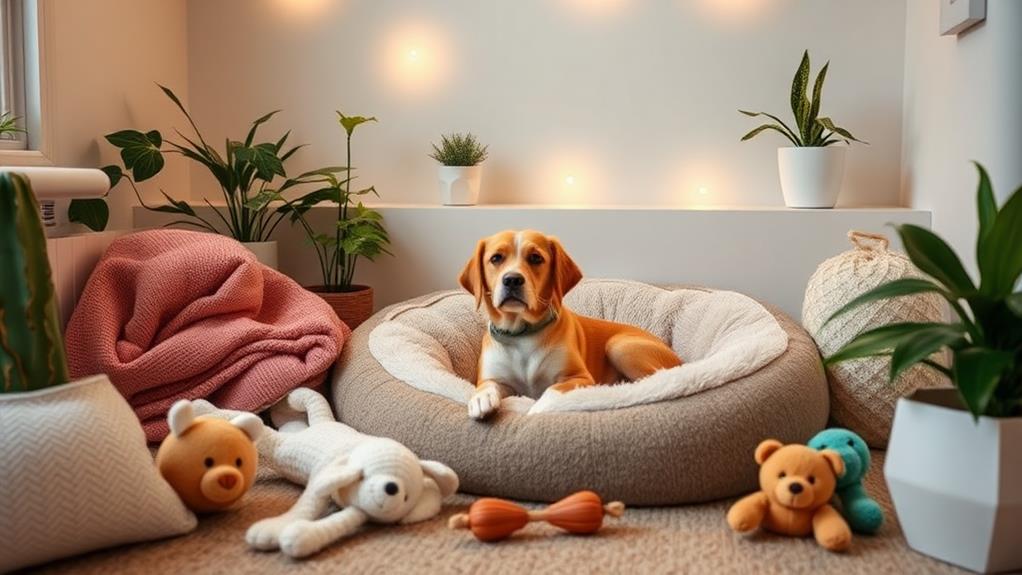
Creating a safe space for your dog is essential, especially if they're prone to anxiety. This designated area should be quiet, comfortable, and free from distractions. You can start by choosing a location in your home that feels secure for your dog, such as a cozy corner or a specific room.
Next, equip this space with your dog's favorite blanket, toys, and even a bed where they can relax. Adding familiar scents, like a worn piece of clothing, can enhance their sense of security. Make sure the area is free from loud noises and sudden movements, allowing your dog to retreat whenever they feel overwhelmed.
You might also consider using a crate, as long as your dog views it positively. A crate can serve as their personal den, providing them with a sense of safety. Always encourage your dog to use this space during stressful situations, like thunderstorms or when guests arrive.
Desensitization and Counter-Conditioning
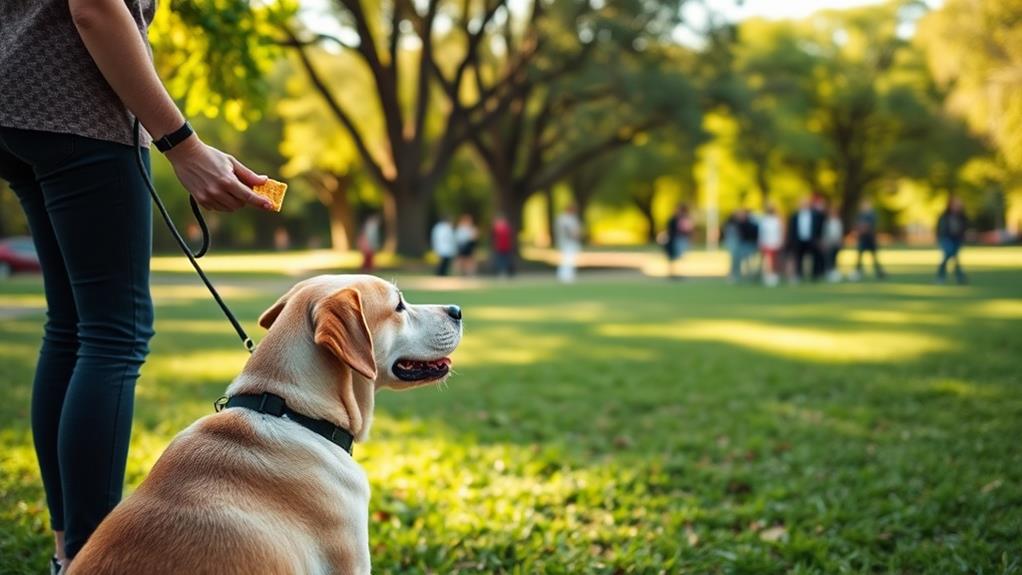
Once your dog has a safe space to retreat to, it's time to focus on desensitization and counter-conditioning techniques. These methods help change your dog's emotional response to anxiety-triggering situations.
Desensitization gradually exposes your dog to the anxiety source at a low intensity, while counter-conditioning pairs this exposure with something positive.
Start by identifying specific triggers, like loud noises or unfamiliar people. Then, follow these steps:
- Controlled Exposure: Introduce your dog to the trigger from a distance where they feel comfortable.
- Gradual Approach: Slowly decrease the distance over time, ensuring your dog remains calm at each stage.
- Positive Reinforcement: Reward your dog with treats or praise when they remain relaxed during exposure.
- Monitor Progress: Keep track of your dog's reactions and adjust the exposure level as needed.
The Role of Exercise
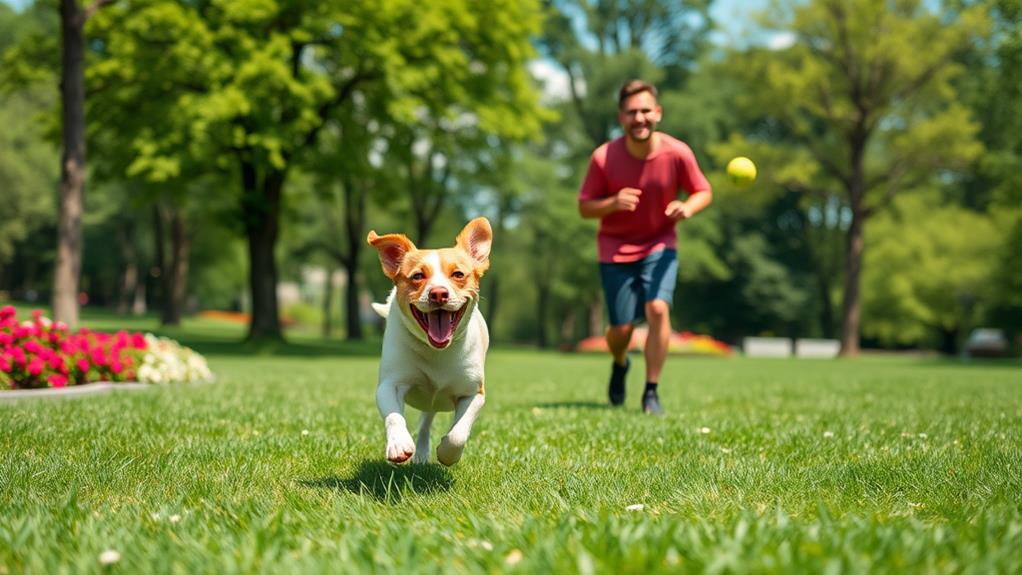
Exercise plays an essential role in managing your dog's anxiety levels. Regular physical activity helps release pent-up energy, which can considerably reduce stress and restlessness.
When your dog engages in exercise, their body produces endorphins, natural chemicals that promote feelings of happiness and relaxation. This boost in mood can alleviate anxiety and improve their overall emotional state.
Incorporating daily walks, play sessions, or even agility training can keep your dog mentally and physically stimulated. Make sure to tailor the intensity and duration of exercise to your dog's age, breed, and health condition. Remember that consistency is key; establishing a routine will help your dog feel more secure and less anxious.
Pay attention to your dog's body language during exercise. If they seem overwhelmed or overly excited, adjust the activity level accordingly. Additionally, consider varying the environment by exploring new parks or trails to keep things interesting. This not only provides physical benefits but also encourages mental engagement, further helping to alleviate anxiety.
Ultimately, by making exercise a priority in your dog's daily routine, you'll create a happier, more balanced companion who's better equipped to handle stress.
Socialization Strategies
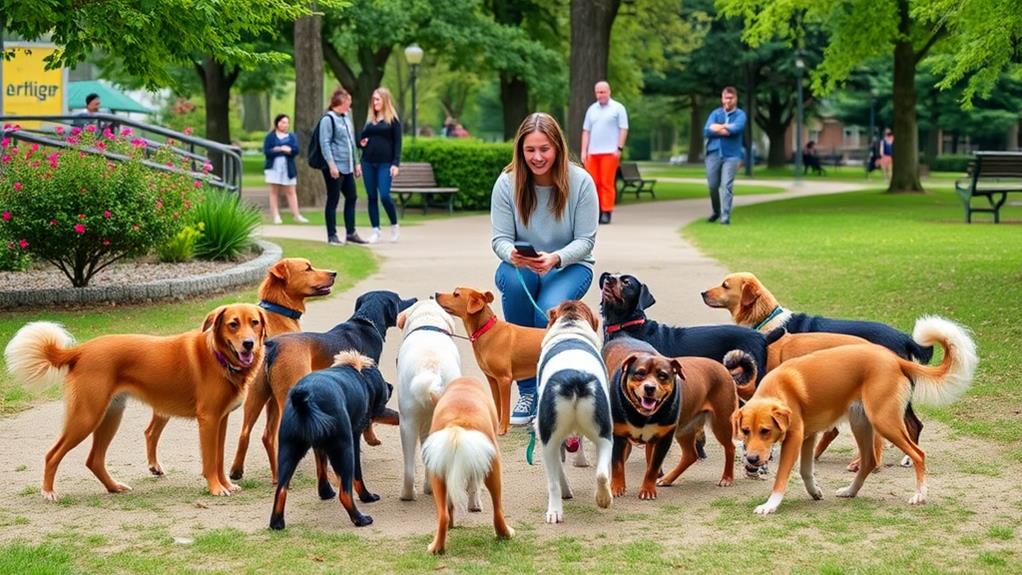
Many dog owners overlook the importance of socialization in reducing anxiety. When your dog interacts with various people, animals, and environments, it helps them build confidence and feel more comfortable in different situations. By exposing your dog to new experiences, you can drastically lower their anxiety levels and enhance their overall well-being.
Puppy Classes: Enroll your puppy in a socialization class to meet other dogs and people in a controlled environment.
Regular Outings: Take your dog on walks in busy areas, like parks or shopping districts, to expose them to different sights, sounds, and smells.
Playdates: Arrange playdates with friendly dogs you know. This helps your dog learn social cues and have fun in a safe space.
Positive Reinforcement: Reward your dog with treats and praise when they encounter new situations calmly, reinforcing their good behavior.
Calming Tools and Aids
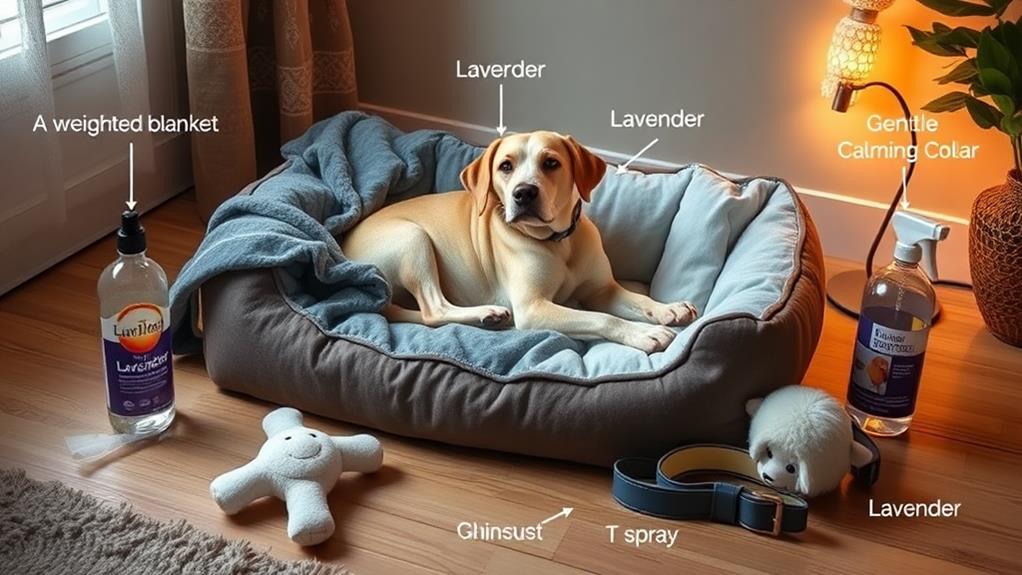
When it comes to helping your dog manage anxiety, calming tools and aids can be incredibly effective. These tools not only promote relaxation but also provide a sense of security. Some popular options to ponder:
| Calming Tool | Description |
|---|---|
| Thundershirt | A snug-fitting garment that applies gentle pressure, mimicking a comforting hug. |
| Calming Chews/Supplements | Specially formulated treats that can help reduce anxiety through natural ingredients. |
| Anxiety Wraps | Similar to Thundershirts, these wraps apply consistent pressure to soothe your dog. |
In addition to these tools, creating a calm environment can further enhance their effectiveness. Soft music, dim lighting, and a cozy space can help your dog feel safe. Remember, while these aids can be beneficial, they should complement your training efforts rather than replace them. Always monitor your dog's response to different tools, as each dog is unique. By combining these calming aids with proper training techniques, you're setting your furry friend up for a more relaxed and confident life.
Training for Specific Triggers
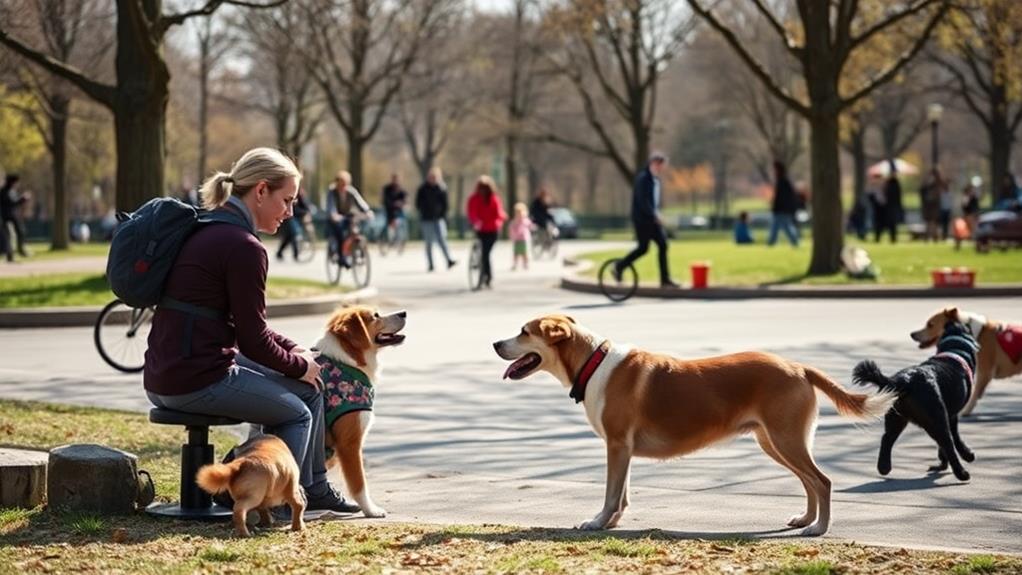
While calming tools and aids provide immediate relief, addressing specific triggers is key for long-term anxiety management in dogs. Identifying what sparks your dog's anxiety—be it loud noises, strangers, or specific environments—allows you to tailor your training efforts effectively. Start by exposing your dog to these triggers gradually and in a controlled manner.
Use positive reinforcement to reward calm behavior during these encounters. This not only helps your dog associate the trigger with something positive but also builds their confidence over time. Here are some techniques to ponder:
- Desensitization: Gradually expose your dog to the trigger at a distance, slowly decreasing that distance as they become more comfortable.
- Counter-conditioning: Pair the trigger with treats or favorite toys to create a positive association.
- Controlled exposure: Practice in a safe, quiet environment before introducing busier settings.
- Routine: Establish a predictable routine that includes training sessions focused on dealing with specific triggers.
Seeking Professional Help
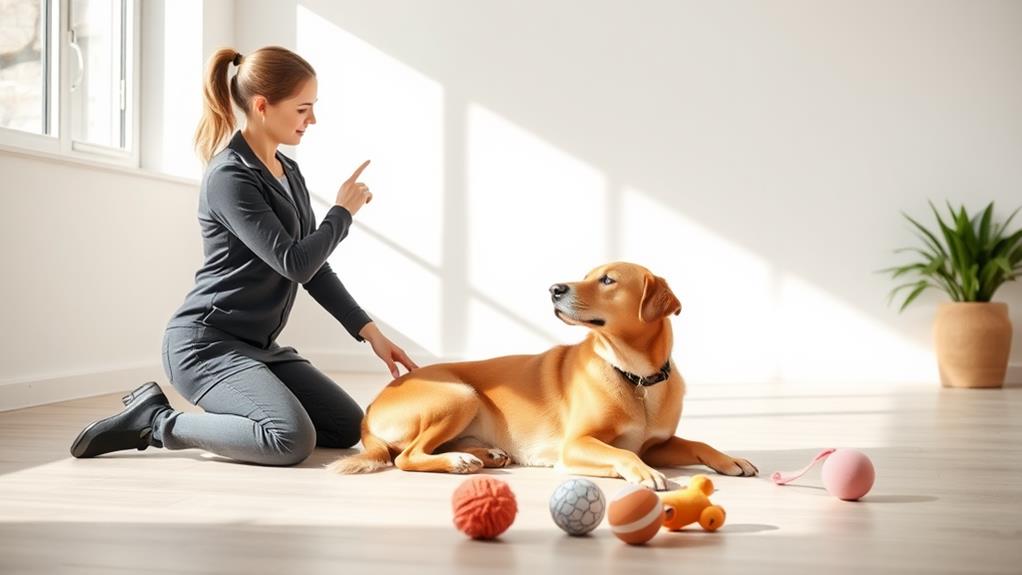
If you've tried various training techniques but still see your dog struggling with anxiety, it might be time to ponder seeking professional help. Professional trainers and behaviorists can offer tailored strategies that address your dog's specific needs. They've the expertise to identify underlying issues that may not be obvious to you.
When you consult a professional, they'll conduct a thorough assessment of your dog's behavior. This evaluation helps determine the root causes of anxiety, whether it's due to past trauma, lack of socialization, or specific triggers. With this information, they can create a customized training plan designed to gradually desensitize your dog to anxiety-inducing situations.
Moreover, professionals often employ advanced techniques, such as counter-conditioning and desensitization, which might be more effective than what you've tried on your own. They can also guide you on proper handling methods and provide tips for creating a calming environment at home.
Frequently Asked Questions
How Long Does It Take to See Results From Training?
When you start training, you might see initial results within a few sessions, but lasting changes typically take weeks or even months, depending on consistency, your dog's temperament, and the techniques you use. Stay patient!
Can Certain Dog Breeds Be More Prone to Anxiety?
"Birds of a feather flock together." Certain dog breeds, like Border Collies or Chihuahuas, can indeed be more prone to anxiety. You'll notice their sensitivities, which can impact training and socialization efforts.
Are There Dietary Changes That Help With Dog Anxiety?
Yes, dietary changes can help with dog anxiety. You'll want to ponder incorporating omega-3 fatty acids, high-quality proteins, and certain calming herbs into their meals. Always consult your vet before making significant dietary adjustments.
Is It Safe to Use Medication Alongside Training Techniques?
Isn't it wise to combine medication with training? Yes, it's generally safe, but always consult your vet first. They'll help you find the best balance for your dog's needs while ensuring effective training.
How Can I Tell if My Dog Is Improving?
You can tell if your dog's improving by observing their behavior. Look for reduced stress signs, increased confidence, and engagement in activities. Also, track their response to triggers and note any positive changes over time.
Conclusion
Just like a ship needs a steady hand to navigate stormy seas, your dog needs your guidance to sail through anxiety. By applying these proven training techniques, you're not just calming your furry friend; you're building a bridge of trust and understanding between you two. Remember, each small step leads to calmer waters. Embrace the journey, stay consistent, and watch your pup bloom into a confident companion, ready to face the world with you by their side.

